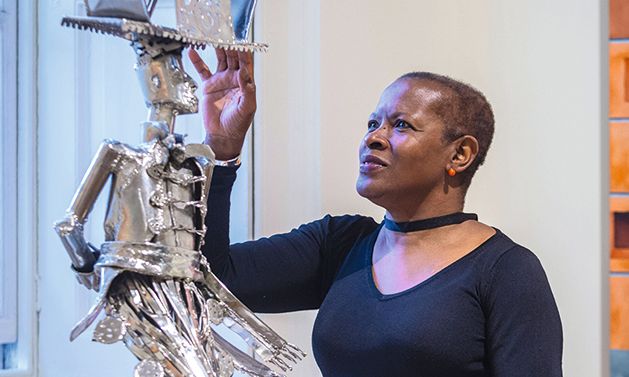Sokari Douglas Camp with her Wavering PG Tips (2022) at last year’s 1-54 fair Stephen Chung/Alamy Stock Photo
Slade to Zaria—which refers to the prominent art schools in London and Nigeria—is a contemporary art column by Chibundu Onuzo, a novelist and fellow of the Royal Society of Literature.
There’s nothing I love more than the ‘discovery’ of a Black artist who has been working for decades. Discovered by whom, you might ask? Well, the people who put artists in museums and give them retrospectives and write up critical reviews that ultimately usher them into art history.
I’m always curious about the inner lives of these ‘discovered’ artists. They often have inscrutable expressions when photographed by the press. In some faces, I see a hint of relief that they won’t share the fate of Van Gogh: ignored in life, celebrated in death. In others, I sense annoyance: “What took you guys so long?”
I think of Faith Ringgold, whose radical, compelling work has found the audience it deserves. I think of Everlyn Nicodemus, whose self-portrait was purchased by the National Portrait Gallery when she was in her sixties. I think of Frank Bowling, whose magisterial Map series did not receive much notice at the time of its painting.
It seems the gaze of the wider art world is finally swinging to the sculptor Sokari Douglas Camp. She was born in 1958 in Buguma, part of the Niger Delta region in Nigeria. The area is ecologically diverse and also rich in crude oil. The extraction of this oil by international companies has led to the devastation of much of her homeland.
Douglas Camp works in steel, an industrial material that, somehow, she renders poetic. Even when her subject matter is heavily political, her touch remains light and whimsical, almost humorous. Take her sculpture, Wrestling Oil Shell BP (2018), which has been acquired by the Victoria and Albert Museum (V&A). Two wrestling figures balance precariously on a barrel of oil, representing the international companies wrestling over Nigeria’s crude. She has captured them mid-wrestle with arms wrapped around each other in a deathly embrace. You can feel the strain in their muscles, the pressure in their grip.
There’s something tragic about these figures. Their features are indistinct and they could be brothers: Romulus and Remus or Cain and Abel. And yet there’s something comical about them, too. They are rendered in pedestrian steel, not heroic marble or noble wood. They are ridiculous tin men with no hearts. And there can be no victor. Whoever wins their contest cannot stay balanced on an oil barrel that looks poised to go up in flames. The work is a profound commentary on the oil industry in Nigeria.
However, Douglas Camp’s work does not just comment on Nigeria. The forces that still shape present-day Nigeria were unleashed centuries ago. In Europe Supported by Africa and America (2015), Douglas Camp is inspired by a William Blake drawing with the same title. The monumental sculpture was temporarily shown in the Dorothy and Michael Hintze Galleries in the V&A.
I saw the work while it was on display amid sculptures by Michelangelo, Bernini and Rodin. The piece was right at home, figures sculpted to a different archetype of beauty, a different way of seeing the world. In the piece, three women stand like the three graces, the central figure of Europe supported by Africa and America, a garland draped across all three. On closer inspection, you realise that on each end of the garland, a petrol nozzle dangles. For centuries, the extraction of natural resources is how Africa and the Americas have propped up Europe.
Political commentary aside, you cannot ignore the beauty of the work. The three women are resplendently dressed in traditional Nigerian style. Copper leaf shimmers on their skin and on their geles that sit like crowns on their heads. Their features are unmistakably African.
Despite the artist’s work being held in the permanent collections of the Smithsonian and the British Museum, despite being shortlisted for Trafalgar Square’s Fourth Plinth, despite being awarded a CBE in 2005, no major British museum has given Sokari Douglas Camp a solo show.
I believe that where the name Louise Bourgeois is known, the name Sokari Douglas Camp should also be known. Not only do both artists work in steel, but they have both made profound artistic contributions in the medium. Douglas Camp’s technique is unique. She does not cast her sculptures. She welds, cuts and bends sheet steel, wielding a blow torch as skilfully as other sculptors have wielded an adze.
Bourgeois’s work is profoundly psychological: sculpture of the interior landscape. Sokari’s work is profoundly political: sculpture that reflects the history of nations. And yet, Sokari’s work is also beautiful. The ideas behind her work are not blurred by beauty but are, instead, sharpened by it.
There are three places in London where I know you can see a sample of Douglas Camp’s work on permanent display: the V&A, the British Museum and the Africa Centre in Southwark. Morley Gallery will also have her work on display as part of its Embodied exhibition until 28 October. Outside London, she is part of the group show, Black Atlantic: Power, People, Resistance, at the Fitzwilliam Museum in Cambridge until 7 January 2024. Let’s hope that a retrospective at a major UK museum is in the pipeline for her. It’s about time.
• Read Chibundu Onuzo's monthly column Slade to Zaria here

